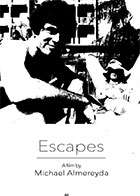
Escapes 2017
Distributed by Grasshopper Films, 12 East 32nd St., 4th Floor, New York, NY 10016
Produced by Michael Almereyda, Wes Anderson, and David Brendel
Directed by Michael Almereyda
DVD , color, 89 min.
College - General Adult
Actors, Biography, Film History, Screenwriters
Date Entered: 01/12/2018
Reviewed by Andy Horbal, University of Maryland LibrariesIt is only natural that last year’s release of Blade Runner 2049 would have brought with it renewed interest in its screenwriter Hampton Fancher. After all, there’s something inherently fascinating about the idea of a “one-hit wonder,” a description that, based on his IMDB page, seems to fit Fancher to a T: although his filmography begins with a slew of small acting roles, nothing much appears on it between the release of the first Blade Runner movie (which he also wrote the screenplay to) in 1982 and its sequel 35 years later. What perhaps is surprising is that there could be enough of a story here to support an entire feature-length film. Sure enough, Escapes worryingly begins with a rambling, 15 minute-long tale about a time Fancher tried to get money back from an ex-boyfriend of the actress Teri Garr, whom he used to date. While the narrative itself is mundane, though, the wall-to-wall film and television clips that accompany it suggest that director Michael Almereyda has something else in mind other than a standard-issue biographical documentary.
The mystery deepens with the next section, titled “The Brain Eaters,” which employs nearly the opposite approach in recounting Fancher’s early life, from his birth in 1938 until his divorce from his second wife, the actress Sue Lyon, in 1964. In contrast to the one that Escapes begins with, this story has an epic sweep: we learn that Fancher was arrested for gang fighting and grand theft auto at the age of 15; that he ran away from home the next year and took a freighter from Galveston, Texas to Barcelona, Spain to become a flamenco dancer; that on his way back to the United States he was invited to dinner by Marlon Brando and Salvador Dali; that he was threatened at gunpoint after having an affair with a policeman’s wife; that he also lived briefly lived with a “schizophrenic lingerie model”; and that his movie career started when actor/director Bruno VeSota spotted him walking down the street and shouted to him, “Hey, wolfboy, want to be in a movie?,” leading to an uncredited appearance in the indie horror film The Brain Eaters. These fantastical events are presented in a series of 59 title cards punctuated only briefly by archival photographs, films clips, and comic panels, as though nothing short of a big-budget biopic could do justice to such a life, so why bother trying?
Gradually, a method emerges to the madness: we realize that the chapter titles given to each section of the film are taken from movies and television programs that Fancher appeared in, and that the clips which begin appearing in abundance again in the third section (“It Was Always Fun For Me”) and pepper the rest of the film all feature Fancher and/or the other actors or actresses he’s talking about. All of this lends Escapes an almost experimental quality: it’s part collage film, part celebration of character actors as the unsung heroes of Hollywood, part meditation on the cause-and-effect relationship between an actor’s persona and the roles they play. It also likely explains why some less obviously relevant stories were included in the film (because they were compatible with the available footage).
The second half of the film is less formally inventive than the first, but may have more to offer to the fans of Blade Runner that constitute it’s most likely audience. Chapter five tells the tale of how Fancher came to meet Philip K. Dick, who denied his request to option the short story “Do Androids Dream of Electric Sheep?,” chapter six explains how he came to have the opportunity to turn it into a screenplay anyway after his close friend Brian Kelly purchases the rights at Fancher’s suggestion, and chapter seven is full of factoids and stories from the set that wouldn’t be out of place on a Blade Runner DVD extra. Unfortunately, for as interesting as some of the material in this last section is, it can’t help but weigh down a film that almost everywhere else feels like it’s on the verge of floating off into space.
Escapes ends with a coda about the word “duende,” which Fancher describes as a “very Spanish” concept which refers to “anything that has death in it and wants to live beyond its limits” and “something that’s crazy, that can’t be relied upon.” In other words, there's a certain nobility in failing because you stretched your limits and reached too far. Michael Almereyda doesn’t fully succeed in solving the puzzle of how to include enough content related to Blade Runner to satisfy viewers who wouldn’t otherwise be interested in a documentary about an obscure screenwriter while remaining true to his subject’s unconventional life, but that shouldn't detract from everything the film does achieve. Like Hampton Fancher himself, it has duende.